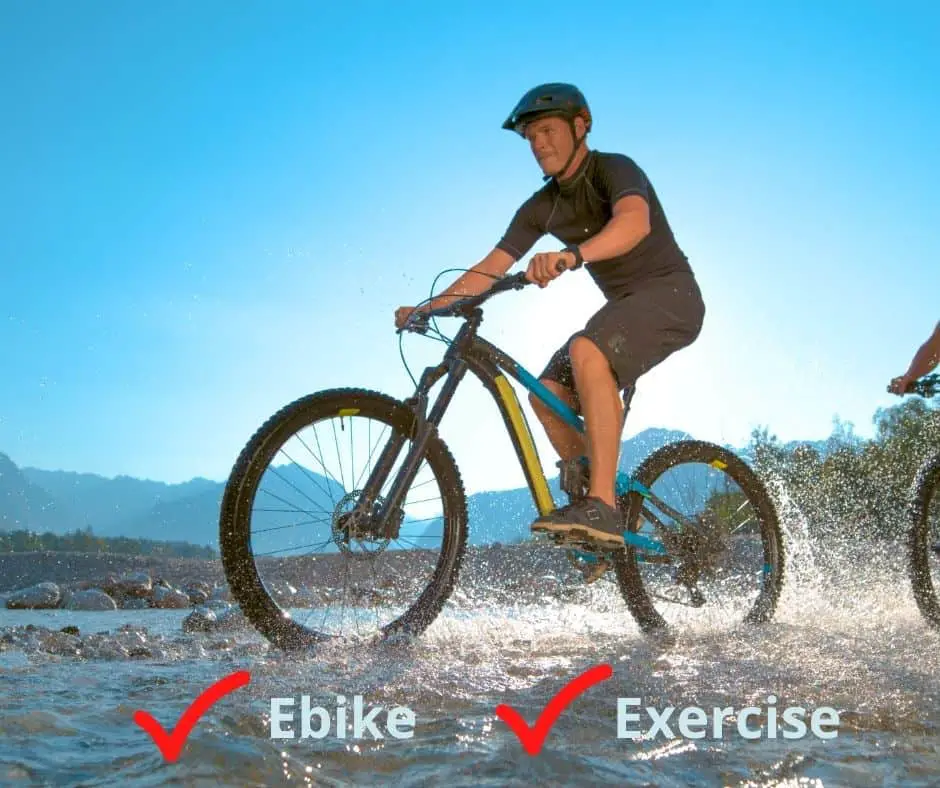Many people love to bike, but some avoid even trying long bike treks or biking at all because they aren’t strong enough to go the distance or are unable to handle the hills. An e-bike can help with this, but do you get exercise by using an e-bike instead of a conventional one?
You can get exercise on an e-bike. An e-bike allows peddling like other bikes, and you only use the power source when you need it—having the motor to fall back on results in bikers taking longer trips and getting more exercise. Also, an e-bike works well with a new, effective way to work out with High Intensity Interval Training — HIIT.
The next sections will explain what an e-bike and HIIT are. Included are references to studies that show how using an e-bike compares to the physical activity gained from riding a conventional bicycle. Also discussed are how to choose the best e-bike for your purposes and which type of motor you will need.

What Is an E-bike?
An e-bike, sometimes called a pedal-assist or electric-assist bicycle, is a bike with an option to use a motor to propel it. It’s a regular bicycle with parts added to it, including a motor, a controller, and a battery.
The most common misconception that people have about electric bikes is that they’re similar to a motorcycle. Just because it’s a two-wheeled mode of transportation with a motor doesn’t mean it’s exercise-free. That being said, e-bikes have specific laws and regulations, so it’s worth investigating such rules wherever you live.
So, if it doesn’t make you go as quick as a motorcycle, what does the motor do?
It provides pedal assistance, which helps bikers overcome headwind resistance and high or multiple hills, allowing them to accelerate more efficiently than manually pedaled bicycles can.
Evelo, which makes electric bikes, explains that e-bikes handle and pedal like any other bicycle. The motor is not meant to replace human power; it’s just meant to augment it, allowing you to travel farther without wearing you out. And although it may not replace your car, it will certainly get you more exercise than driving!
Once you’ve checked your local regulations, it’s time to upgrade your manual bicycle to an improved model. As you’ll soon learn, you can get an incredible workout from an e-bike and there are so many other reasons to get an ebike. Grab your helmet and read on below to discover the muscle improvements and heart-healthy benefits of the fitness industry’s newest member.

Can E-Bikes Provide at Least As Much Exercise As Regular Bikes?
A study done in 2019 in Europe by Transportation Research Interdisciplinary Perspectives produced findings that suggest, not surprisingly, that e-bike users who switched from using their cars and public transport experienced “substantial increases in physical activity.”
It also found that any decrease in physical activity resulting from regular cyclists switching to e-bikes was canceled out by the overall increase in travel distance associated with e-biking. People who used e-bikes went further, meaning they made up for the same amount of exercise while being able to see more of the town, park, or country road.
Another smaller study done by Brigham Young University health professors in November 2019 found that e-bikes can provide the same intensity of exercise as manually pedaled bikes, without the cyclist feeling taxed by the workout. These researchers used “a 6-mile test loop” to compare heart rates of conventional mountain bike cyclists with those riding e-mountain bikes.
They found that cyclists on both types of bikes “reached the upper-half of the vigorous-intensity zone for target heart rate.” In other words, e-bikes are more than capable of providing high-level workouts, even though they provide a boost. The only difference is that you’ll have to go a little bit further to see the same results.
Many people believe that e-bikes aren’t an adequate form of exercise. After all, there’s an assistive motor that does some of the work for you. However, it’s designed to increase your speed and provide a smooth ride, not reduce the health benefits. Many cyclists have made the transition to e-bikes to broaden their horizons and try a new form of exercise.
Two of the best benefits of riding a manual bicycle are that you improve cardio vascularity and your leg muscles get a good workout. You’ll receive both of those from an e-bike. If you want to learn an ideal fitness routine to try with your new e-bike, proceed to the next section.
How Can E-bikes Be Used in High-Intensity Interval Training (HIIT)?
A 2016 study, funded by the Natural Sciences and Engineering Research Council and a McMaster University grant concluded that twelve weeks of brief high-intensity interval training (HIIT) improved cardiometabolic health in a group of participating subjects. To the same extent, that traditional endurance training improved cardiovascular health in the other participants, even though the HIIT group did less exercise with less time commitment.
Once you understand how HIIT, interval, or burst training works, you don’t need a study to tell you how e-bikes can provide this kind of exercise. This involves alternating between “bursts” of intense exercise (1-5 minutes) followed by short periods of rest or less-intense movement for about the same amount of time.
Regular bikes, which require intense pedaling uphill, followed by the relaxed state as you coast downhill, also work well for burst training. Simultaneously, E-bikes can provide the perfect relax-mode after intense peddling on either flat or hilly terrain. It’s important to let your heart wind down rather than suddenly stopping.

E-bikes have become a big part of the fitness industry, especially in big cities such as Los Angeles or San Francisco. Wide streets and rolling hills allow people to choose the intensity of their workout without having to go to the gym. Unlike traditional bicycles, they’ll have the freedom to reduce the intensity instead of pushing themselves too far.
Perhaps the best way to do HIIT training on an E-bike would be as follows:
- Find a long path with varying elevations. It’s best if you can pedal on a flat surface for one minute, then navigate your way up a hill. Keep in mind that HIIT is only effective if you’re giving it everything you’ve got.
- Follow the route for up to 5 minutes. After the session, slow down to an easy pedal for about 45 seconds to catch your breath and bring down your heart rate. Coasting down a hill is a good way to perform this step.
- After the break, slowly gain momentum over the course of one minute, then continue the same method as mentioned in step 2. Repeat this process for three to four sessions.
That’s all there is to it! HIIT training is a great way to improve your heart health, boost muscle growth, and cut back on body fat. E-bikes allow you to take advantage of the high speeds and muscle-engaging pedaling while promoting optimal recovery periods in between HIIT sessions. You can even train in the rain.
Closing Thoughts
The evidence overwhelmingly supports the conclusion that electric bikes are a great way to get exercise because, for one reason, bikers usually go longer distances when using them. Also, they encourage more people who wouldn’t normally ride to choose biking and get the exercise they wouldn’t usually enjoy.
Based on burst training, e-bikes would provide a perfect vehicle for this form of training, which would be more fun and more cognitively beneficial than working out indoors. Whether you’re an advanced cyclist or someone who wants to get outside and break your exercise habits (or lack thereof), e-bikes should be at the top of your list!
